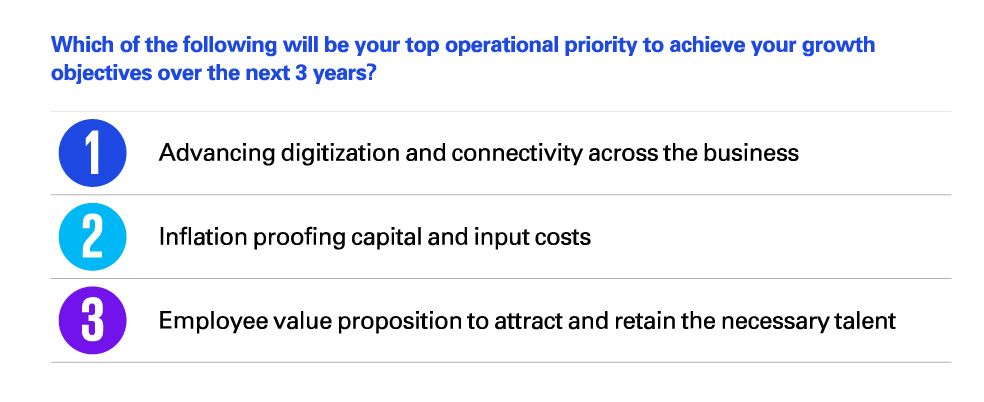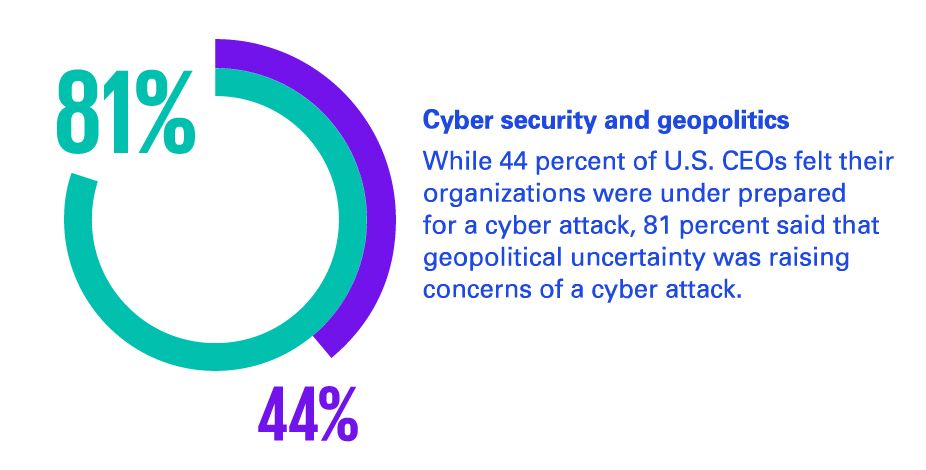
Our continued growth in digital enrollment and engagement across lines of business has been instrumental to our deepening client relationships, as well as in reducing costs and driving efficiencies in how we deliver for our clients.

Brian Moynihan
CEO
Bank of America
While U.S. CEOs have had to make some short-term adjustments, they indicated that advancing digitization and connectivity across the business is the top operational priority for achieving growth over the next three years.
“Emerging technology is disrupting how consumers work, play, think and live, proving to be a potential concern for companies that fail to keep up with their competitors,” says Newinski. “Thinking one step ahead on how disruptive technologies such as blockchain and the metaverse can augment the employee, customer and product experience will provide an opportunity to outpace the competition and create a future-forward positioning.”
“Stitch Fix is in a constant state of digital transformation,” says Elizabeth Spaulding, CEO of Stitch Fix. “Whether that’s using customer feedback, data analysis and stylist expertise to predict style and shopping trends for our clients or updating our platform experience through product updates that improve the client experience, we’ll continue approaching digital transformation like we always have—as an essential part of our entire business.”
A majority of U.S. CEOs (74%) believe they need to act more quickly when shifting investment to digital opportunities and divesting in areas that face digital obsolescence; 78% have an aggressive digital investment strategy intended to secure first-mover or fast-follower status. “There’s a big push to either be leading or a fast follower,” says Carande. “A lot of companies can be outmaneuvered if they can't keep up with disruptive technology.”


“Fashion moves fast,” says Spaulding. “We’ve found that effective use of cutting-edge technology ensures we can move the retail industry forward, meet customer needs and anticipate future trends and market movement.”
The pandemic has seen many companies devise technology-driven solutions to sustain and grow their businesses, mainly by focusing on meeting customer and employee expectations.
“In 2021, we saw record client engagement across our digital platforms,” says Moynihan. “Our continued growth in digital enrollment and engagement across lines of business has been instrumental to our deepening client relationships, as well as to reducing costs and driving efficiencies in how we deliver for our clients.”
Post-pandemic, the big questions have been: To what degree will pandemic-driven expectations and behaviors become permanent? And how should businesses allocate technology investments accordingly? CEOs are also considering which new potentially disruptive technologies, like Web3 and embedded, intelligent software systems, make sense for their companies. Deciding on the right technology and knowing how to keep pace with change (both at 63%) are the two top factors holding back progress on business transformation.
“When selecting the right technologies for your organization, start with thinking about what you are trying to achieve. If you are trying to modernize your tech stack, then there are a lot of new cloud-based enterprise providers to choose from,” says Carande. “But if you are trying to open up new markets and connect with a new customer base, then you may want to consider the potential opportunities from the emerging metaverse and the investments taking place to create a more decentralized internet, referred to as Web3. Within the metaverse, consider what it means to you: Is it a better way to connect with customers and access new talent? Is it a way to create a new marketplace to sell products and services? Can you better serve and support your customers? Or, is it about the ability to better recruit talent and engage with your employee base? Knowing what you’re trying to do is going to help orient you to the types of technologies that offer the most transformational potential in your particular environment.”
While U.S. CEOs have often favored technology over people in terms of their technology investing, this year the trend is reversed, with 54% placing more capital investment in developing workforce skills and capabilities and 46% focusing on buying new technology. In 2021, it was 44% and 56%, respectively.

There's a big push to either be leading or a fast follower. A lot of companies can be outmaneuvered if they can't keep up with disruptive technology.

Carl Carande
Vice Chair - Advisory for KPMG U.S.
and Global Head of Advisory
“We don’t see people and technology as a true tradeoff—we see the two working together as a force multiplier,” says Spaulding. “Technology and humans bring out the best in each other. We’re amid a multiyear endeavor to change the way people shop, and that requires a strong team armed with the best tools.”
“The success of digital transformation hinges on having a clear strategy and communicating the objectives of your digital transformation strategy throughout your whole organization, from the C-suite to your call-center employees,” says Carande. “It takes a transformation of culture to succeed at digital transformation.”
Such a cultural transformation needs to run deep and often uproots the status quo. Fifty-five percent of U.S. CEOs believe the act of managing the cultural impact is holding back the progress of business transformation in their organizations. Recognizing the importance of change management—and supporting cultural transformation from the very top—are key elements of success.
“We want to make sure that we drive the right culture in the company that is based on a growth mindset and a customer focus,” says Dallas. “That means having the right tools to identify when we’re in a fixed mindset and shifting so that we get creative when working with customers on new solutions.”
Change management is key for Ford Pro, which is making truck ownership a digital experience that provides customers with software, battery charging, financing and support. Expanding from only selling vehicles to offering integrated, softwaredriven ownership solutions required the company to rethink its internal structures and how it pursues digital transformation. The new integrated offer has “completely changed how we work, what we measure, what kind of talent we employ,” says Cannis.
During the pandemic, many companies equipped employees with new digital tools, opening new pathways for cybercriminals. This year’s survey reveals that just 39% of U.S. CEOs believe their organizations are well prepared for a cyberattack, which is less than in previous years.
Kyle Kappel, KPMG U.S. Leader for Cyber Security, sees the low number of CEOs who believe their organizations are prepared for cyberattacks as a positive sign. “I view this as an increase in awareness about the importance of cyber security that is taking place at the highest levels of the organizations,” he says.

Technology and humans bring out the best in each other. We’re amid a multi-year endeavor to change the way people shop, and that requires a strong team armed with the best tools.

Elizabeth Spaulding
CEO
Stitch Fix
The next step is to translate that awareness into action. “Being better prepared for cyberattacks will take a culture that puts the highest value on cyber security,” says Kappel. “The tone from the top plays a huge role in creating a cyber-aware culture, which needs to take hold across the whole organization, not just IT.”
Kappel believes the lack of cyber preparedness should drive, not derail, digital transformation. As an example, he says, organizations that are moving from legacy on-premises technologies to cloud-based solutions stand to benefit in terms of cyber security provided by hyperscale cloud providers.
Digital transformation can also alleviate other risks, such as those imposed by economic and geopolitical factors. Sixty-eight percent of U.S. CEOs agree that current issues, including Russia’s invasion of Ukraine, the climate crisis, deglobalization and risk of stagflation, are cause for concern as those issues may interfere with their digital transformation strategy.
“Since mid-pandemic, when the fragility of the supply chains was exposed, CEOs have had a much bigger recognition of the importance of their supply chains to deliver on their brand promise,” says Brian Higgins, KPMG U.S. Customer & Operations Practice Leader, Commercial Industries. “Additionally, the organizations are now subjected to more risks and a wider set of consequences when their supply chains are disrupted, including cyber security, pandemicrelated issues or ESG.” Having more visibility and digital connectedness within their supply chains can help companies with their ESG initiatives, since the complexity of decarbonizing supply chains is currently the top barrier (30%) to achieving net zero or similar climate ambitions at global corporations.
But while the recognition of the importance of the supply chains is higher, many companies have not yet taken the necessary steps to digitalize their supply chains and eliminate the structural issues that can lead to disruptions, says Higgins. As a result, many companies are “flying blind” because they don’t have enough visibility into their supply chain and are unable to manage its increasing complexity.
Higgins says the modernization deficit facing supply chains has been exacerbated by companies being forced to operate in a permanent crisis mode. But the crisis mode is not sustainable long term if companies want to avoid risks and use their supply chain as a competitive advantage. Companies should use the lessons revealed by the pandemic and invest further in digitalizing their supply chains, says Higgins.


In addition, 80% of U.S. CEOs say the proposed global minimum tax (GMT) regime is of significant concern to their organization’s growth goals. “As governments continue to iron out details on the potential implementation of the OECD’s proposal for a GMT, now is the time for companies to leverage data to model its potential impact and scenario plan,” says KPMG Tax Vice Chair Greg Engel. “The failure to do so in a timely manner could significantly limit their ability to prepare for the adoption of a GMT and put them at a competitive disadvantage.”
